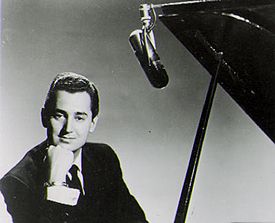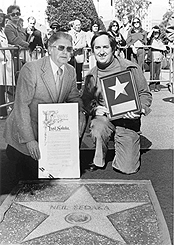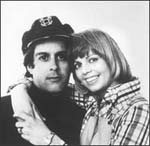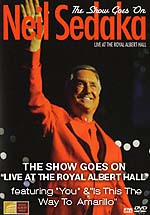 Neil Sedaka
Neil Sedaka
'Still Keeping It Together'
It is hard to imagine the history of rock and roll without the many contributions of Neil Sedaka. For over four decades, Sedaka's timeless standards have helped change the face of popular music.
With countless hit singles, and platinum and gold records, he is recognized as one of rock and pop music's legendary pioneers, and remains as vital a force today as he was when he first achieved his string of hits back in the late 1950's.
He began performing on the piano as a youth and played on a classical music radio station, as well as studying at Juilliard. He also began experimenting with doo wop and rock and roll, singing and playing in an early version of The Tokens. His composition "Stupid Cupid" was a 1958 success for Connie Francis and Sedaka was signed to RCA Records as a solo performer. A string of hits followed.
The best-known Billboard Hot 100 hits of his early career are "Oh! Carol" (#9, 1959), "Calendar Girl" (#4, 1960), "Happy Birthday Sweet Sixteen" (#6, 1961), and "Breaking Up Is Hard to Do" (#1, 1962). "Oh! Carol" references Sedaka's Brill Building compatriot and former girlfriend Carole King. King soon responded with her own answer song, "Oh, Neil," which directly references his song (and his full name). A Scopitone exists for "Calendar Girl".
 In 1973, Sedaka began working in England with Elton John, who signed him to his Rocket Records label. Following a decade-long fallow period, Sedaka returned to the public's attention with a flourish, topping the charts twice "Laughter in the Rain" and "Bad Blood" (both 1975). Sedaka and Greenfield also co-wrote "Love Will Keep Us Together", a No. 1 hit for The Captain and Tennille and the best selling record of 1975.
In 1973, Sedaka began working in England with Elton John, who signed him to his Rocket Records label. Following a decade-long fallow period, Sedaka returned to the public's attention with a flourish, topping the charts twice "Laughter in the Rain" and "Bad Blood" (both 1975). Sedaka and Greenfield also co-wrote "Love Will Keep Us Together", a No. 1 hit for The Captain and Tennille and the best selling record of 1975.
Sedaka is also the composer of the popular "Is This The Way to Amarillo", a song he wrote for Britain's Tony Christie. It reached #18 on the UK charts in 1971, but hit #1 when reissued in 2005, thanks to an amusing cameo-filled video starring comedian Peter Kay. Sedaka recorded the song himself in 1977, when it became a #44 hit. On April 7, 2006, during a concert at the Royal Albert Hall in London, Neil Sedaka was presented with an award from the book Guinness World Records: British Hit Singles and Albums as the writer of the Best-Selling Single of the 21st century for "Amarillo".
In 2006, Sedaka continues to perform regularly. He has a star on the Hollywood Walk of Fame and was inducted into the Long Island Music Hall of Fame in October 2006.
Next year marks your 50th anniversary of life in show business … fifty years, Neil! ”I know, I can’t believe it myself,” he laughs. ”I have performed in practically every country in the world as an American musical ambassador. Next year they are giving me – although it’s not for sure – but there could be a couple of tributes to me. One would be at Carnegie Hall where the New York Pops are thinking of honoring me, along with Quincy Jones. It's where people would sing my songs.”
 Very nice and what a fitting tribute to someone such as yourself "I’ve worked very, very hard over the years. It doesn’t come easily.”
Very nice and what a fitting tribute to someone such as yourself "I’ve worked very, very hard over the years. It doesn’t come easily.”
After all those years in the business, is there one memory that still remains your fondest, perhaps? ”I’ve had some wonderfully exciting things happen to me. I had a street sign put up in Brooklyn, New York – Neil Sedaka Way – I’ve had my name encrusted into the Hollywood Walk Of Fame, I was inducted into the Songwriters Hall of Fame. And I was on American Idol in 2004 where five singers sang all of my songs.”
Although you studied at The Juilliard School you never actually graduated. Yet, this past October 14th you were honored by the New York Alumni Association at their 21st Annual New York Reunion. Why didn't you graduate the first time and how did the event go? ”Well, I entered the school at 17 and at 19 I signed to RCA/Victor Records as a singer/songwriter. So, I left! And yes, this year they had the New York Alumni Society in Los Angeles. They honor someone every year and this year I was chosen. These are the people that went to the New York City high schools and who migrated to Los Angeles. So, this year I was honored and a gentlemen from Juilliard came out and gave me a plaque; a very special award.”
Taking you back for a moment, and having formed a doo-wop group in high school called The Tokens, at what point did you find that pop and rock 'n roll (that was playing more and more on the radio) began influencing you more, pulling you away from your classical piano training? ”Well, I started playing piano with a private teacher in Brooklyn, NY at eight years old. At nine I entered the prep school at Juilliard School of Music under a scholarship I had for the piano. Then at thirteen I discovered I could write songs. As a teenager I listened to a program called ‘The Make Believe Ballroom’ which was a very popular show that played Rosemary Clooney, Patti Page, Mary Ford … and I started to listen to that kind of music. Then when I was in high school with The Tokens it was the doo-wop music that influenced me – music from The Penguins, Life Is But A Dream, and such. So I started writing rock and roll at around sixteen.”
 Yourself and Howard Greenfield became one of the original creators of the "Brill Building Sound" in the late fifties and early sixties. Please explain this movement more to our readers ”Yes, we were one of the first teams. I then brought Carole King and Jerry Dawson in and then Barry Mack, Cynthia Wild, Jeff Barry, Ellie Greenwich, Paul Simon and Neil Diamond – many of these people followed. But, Howie and I were the first at 1650 Broadway which was the first Brill Building. It was 1619 Broadway, but those were the old writers. Young teenager writers like myself went to 1650 Broadway, which was across the street. That was the beginning of the independent music publishers that signed teenagers.”
Yourself and Howard Greenfield became one of the original creators of the "Brill Building Sound" in the late fifties and early sixties. Please explain this movement more to our readers ”Yes, we were one of the first teams. I then brought Carole King and Jerry Dawson in and then Barry Mack, Cynthia Wild, Jeff Barry, Ellie Greenwich, Paul Simon and Neil Diamond – many of these people followed. But, Howie and I were the first at 1650 Broadway which was the first Brill Building. It was 1619 Broadway, but those were the old writers. Young teenager writers like myself went to 1650 Broadway, which was across the street. That was the beginning of the independent music publishers that signed teenagers.”
Did you yourself cultivate any aspiring teenagers back then into the superstars that they are today? ”No, I was too busy promoting my own songs! But, I did bring Carole King who was a protégé of mine, but she went on to do her own thing, and do it very successfully. I became friendly with Connie Francis and wrote many songs for her, including ‘Where The Boys Are’ – for a motion picture – and then Bobby Darin became a friend of mine. He used all of my piano playing on many of his records. Songs like ‘Dream Lover’ and the other side to that single. He loved my piano playing. But no, I never really took anybody under my wing.”
It was in 1958, at the age of eighteen, when you were catapulted into stardom after Connie Francis recorded your "Stupid Cupid." At the time did she have to ask you for it or did you write it and it was sold on to anybody who paid for it? ”Yes, that was my first international hit as a songwriter. I walked into the Brill Building in 1958 with a group of about eight songs and one of them was ‘Stupid Cupid.’ Don Kirschner knew Connie Francis, who was a very hot female artist at the time, and I went to her home and I played her ‘Stupid Cupid.’ I sat at her piano and it was a very heady experience, because she was at the top of the charts with ‘Who’s Sorry Now.’ And the story goes that I played all my best ballads thinking that she would follow with a ballad and at the last minute; as a last after thought, I played ‘Stupid Cupid.’ She then said that it was going to be her next record.”
 In 1975 you also helped to launch the career of the Captain and Tennille with their version of your 'Love Will Keep Us Together.' When the dust had settled did it ever cross your mind that perhaps you should have kept that song for yourself based on its phenomenal success?! “Oh, we’re jumping quite a bit here,” he gently laughs.
In 1975 you also helped to launch the career of the Captain and Tennille with their version of your 'Love Will Keep Us Together.' When the dust had settled did it ever cross your mind that perhaps you should have kept that song for yourself based on its phenomenal success?! “Oh, we’re jumping quite a bit here,” he gently laughs.
”I had ten Top 10 records in a row between 1958 and 1963. I sold about 40 million records worldwide. Then there was a lull between ’63 and ’74, but I met Elton John – who was starting a record company – and he signed me to his Rocket Records. I then had an album called Sedaka’s Back which was a remarkable comeback for me. I was then back at the top of the charts with a song called ‘Laughter In The Rain'."
Why do you claim it to be a ‘remarkable’ comeback? ”Well, eleven years off the chart I was known as a ghost of the ‘50s, one of the original American rock ‘n rollers. Then with a new style, a new type of song, more sophisticated, well ... you know, this is a very trendy business and so after eleven years you would think that might have been the end.”
”Elton then had three albums with me. At that time I was on television. In the early days I was only a host on the radio. But in the ‘70s they saw a face with the voice and they liked the face and so I became quite a seasoned performer, doing many of the theaters, nightclubs, casinos, Las Vegas, Atlantic City, and a lot of television. So, they saw a face with the voice, which helped.”
 With the timeline now filled in, coming back to the 1975 career launch of the Captain and Tennille with their version of your 'Love Will Keep Us Together,' please tell us more about how they reached out ”I recorded it first on an album called Sedaka’s Back. It was actually recorded in Stockport, England with a group called The 10CC’s. Captain and Tennille heard the recording - they were signed to A&M Records in California - and decided to do it as their debut single. It was my first Grammy award. It was the top-selling record of ’75.”
With the timeline now filled in, coming back to the 1975 career launch of the Captain and Tennille with their version of your 'Love Will Keep Us Together,' please tell us more about how they reached out ”I recorded it first on an album called Sedaka’s Back. It was actually recorded in Stockport, England with a group called The 10CC’s. Captain and Tennille heard the recording - they were signed to A&M Records in California - and decided to do it as their debut single. It was my first Grammy award. It was the top-selling record of ’75.”
How many Grammy’s do you actually have? ”Oh, I’ve been nominated many times over the years, but that is the only win.”
Where could we find that Grammy today? Somewhere safe? ”Oh, I have one and the Captain and Tennille have one. Mine is on my mantel alongside my gold records right here on my wall,” he says proudly.
Has there ever been a song that you’ve given away that in retrospect you wish you hadn’t?! ”Yes, ‘Love Will Keep Us Together’ is the one I should have kept for myself. I had just had ‘Laughter In The Rain’ and I should have held that as a single.”
"But you know it’s a very, very big moneymaker as far as the songwriting royalties. I’ve been with Broadcast Music Industry [BMI] since I was a teenager and they log all of the songs that are played on the radio and on the television. People don’t realize that when you hear a record on the radio it’s only the writers that get the royalties. So, Sinatra and Streisand and all the other singers never got royalties from radio plays.”
In this day and age, are royalties pennies or dollars? ”Pennies, but they add up very well,” he gently laughs. ”I’ve written over a thousand songs, and so as you can imagine there’s a penny in England, there’s a penny in Australia ... all over the world they add up.”
Having recorded so many hit songs along the years is there perhaps one that has stayed closest to your heart? ”Well, I haven’t written it yet. I’ve yet to write it. But from the ones in the past there are at least twelve or fifteen of them that will out live me. ‘Breaking Up Is Hard To Do,’ ‘Calendar Girl,’ ‘Solitaire,’ ‘Oh Carole,’ ‘Happy Birthday Sweet Sixteen,' and ‘Is This The Way To Amarillo’ … which last Christmas was the biggest hit single in the UK … and which I wrote 35 years ago!”
 Your new DVD ‘Neil Sedaka: The Show Goes On - Live From Royal Albert Hall’ is quite an impressive venture. When exactly was it filmed and did all go as smoothly as it seemed?! ”Yes, I’m very, very proud of it. The ambiance at the Royal Albert Hall is very special. I had 6,000 people filled to the brim, and I did over two hours of a concert by myself. I did a one-man concert with just my piano and voice, some videos and some stories. I think it’s one of my best concerts in all the fifty years. It was filmed in March of this year.”
Your new DVD ‘Neil Sedaka: The Show Goes On - Live From Royal Albert Hall’ is quite an impressive venture. When exactly was it filmed and did all go as smoothly as it seemed?! ”Yes, I’m very, very proud of it. The ambiance at the Royal Albert Hall is very special. I had 6,000 people filled to the brim, and I did over two hours of a concert by myself. I did a one-man concert with just my piano and voice, some videos and some stories. I think it’s one of my best concerts in all the fifty years. It was filmed in March of this year.”
"There was one section where they had to splice where I did a number with my daughter - who’s on a video - and I sing live with her. That messed up, but they were able to splice it out. So it looks very natural. There were ten cameras. It was very unusual for someone to be able to hold 6,000 people with just a voice and a piano. So, I was very, very proud of it and as a result we did get a gold record for the CD.”
For this new CD/DVD you also wrote some brand new songs. How easy was that to do after all these years of expressing yourself so many times in so many ways? ”Yes, I did. Russ, there is nothing more exciting then presenting a new song and getting a tremendous ovation. I sang a song called ‘You,’ which I think got one of the biggest applause of the evening out of thirty odd songs. Creative people really keep going and developing. Once we start resting on our laurels that’s the end. So, as next year is my 50th anniversary in show business, I have a definitive collection coming out in April on Razor & Tie. It has 25 to 30 records, but not only my hits but some of my hidden treasures, that I call the forgotten children. Some of those that I am still very proud of but got lost in the shuffle. Because years ago I wrote 12 songs for an LP and there was only one or two singles chosen from each LP. So, many of them went by the wayside. But there are things on this upcoming definitive collection that I am very proud of.”
What is your favorite moment of this Royal Albert Hall event for our readers to watch out for? ”Well, I did do a duet with Tony Christie on ‘Is This The Way To Amarillo.’ That was very exciting. I actually also got an award that night. The Guinness World Book of Records came out during the concert and they gave me an award for the top selling record of the 21st Century in the UK."
"But, there’s always something about live performances that remain entertaining to me. Whether it be the adrenaline rush, or the excitement of having people who have paid to see you, it’s my favorite kind of venue.”
Having first achieved your hits back in the late 1950's, how does recording and performing songs today match up to those days? ”Well, today you have so much more freedom. In those days we had to record three singles in four hours. Today, you go in, you put down a piano track or a rhythm track and then the next day you’ll add some horns, the following day some strings. You have much more leisure time. Plus, in those days I had to do something that was ultra, ultra, ultra commercial. Now, after 50 years I’m recording things that are close to my heart; things that are meaningful to me whether they are commercial hits or not."
 "I did an album called Classically Sedaka which was unique. I put my own lyrics in amongst the classical melodies with a symphony orchestra. And then I did a Yiddish album that was a big success. And I’m now going to do a children’s album where I re-wrote the lyrics to all my old hits – ‘Waking Up Is Hard To Do’ and ‘Where The Toys Are.’ So I am always trying something fresh and trying to challenge myself.”
"I did an album called Classically Sedaka which was unique. I put my own lyrics in amongst the classical melodies with a symphony orchestra. And then I did a Yiddish album that was a big success. And I’m now going to do a children’s album where I re-wrote the lyrics to all my old hits – ‘Waking Up Is Hard To Do’ and ‘Where The Toys Are.’ So I am always trying something fresh and trying to challenge myself.”
”I was always a one-take guy in the studio because basically I’m a spontaneous performer. Second, third, fourth takes always went down hill and I find the same thing in live performance. You just never get the chance to do it again so you better make that the best one.”
You recently decided to auction the piano you composed 'Love Will Keep Us Together,' 'Breaking Up Is Hard To Do,' 'Calendar Girl,' and 'Is This The Way To Amarillo' and have the proceeds from the sale donated to several AIDS charities. How did that event go and how much did you raise? ”I think it was $10,000. A fan in Australia won it. It was advertised on the Internet and he bought it. I met him when I did Carnegie Hall a few years ago. He came backstage and I do remember meeting him.”
Finally, just who IS Neil Sedaka? ”A very blessed person. A person that was given a gift who loves to share it with the world. Someone who has, in these terrible times, become an ambassador of goodwill through music. Someone who brings joy to people. You know, I have been given a gift, but I get it back ten-fold from the audience.”
Interviewed by Russell A. Trunk
www.neilsedaka.com
Back To Archives

